Super Detailed 1/24 scale DHC-2
The Mighty Beaver
by George R. Mustafa
|
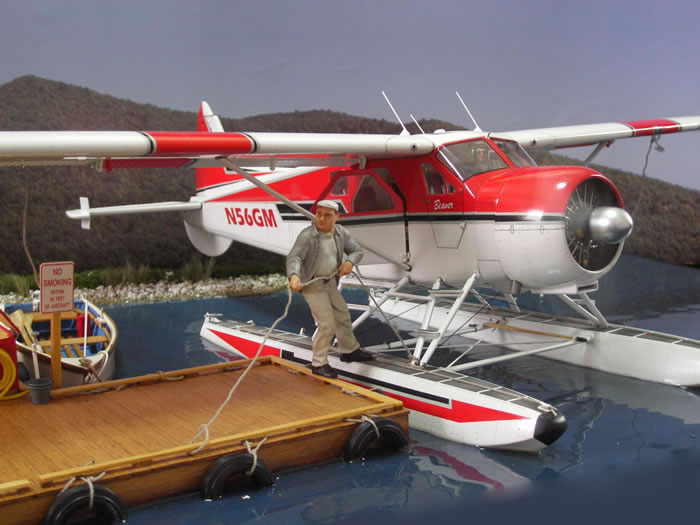
|
DHC-2 Beaver |

HyperScale is proudly supported by Squadron
This is the Mighty Beaver, First Place winning Aviation Diorama at the IPMS 2008 Nationals held in Virginia Beach, Va., August 2008.
This is a 26 part snap together model sold by Cedar Creek Trading Post in Cedarburg, Wisconsin, through an ad in Fine Scale Modeler magazine. Therefore, the model is, for a lack of a better word, generic, meaning the manufacturer is unknown, as for the information I have is that this was a promotional model done for Canadian Mist. The model itself is a very good representation of a 1956 CHC2 Beaver featuring a good looking engine face, and the correct Beaver lines. However, the model does not have windows or interiors, only some decals to represent them.
The model comes in a plastic bag inside a brown cardboard box and when assembled builds into a nice Beaver. I took the lack of details as a challenge and an opportunity to modify and with extensive scratch building, create a great looking, highly detailed Beaver.

In the following images you will see the some of the process of super detailing this magnificent airplane, which included over 110 scratch built items and modifications, some of which are complex multi part items. This project took well over a year and a half and around 1,200 hrs of work. During the process I took well over 400 pictures of the process, which of course, I can’t put them all here. So you will see a small sample of these images that help bring to you the long and tedious work of creating from scratch all the items involved in super-detailing and assembling this plane.
The model was built to represent a modernized 1956 Beaver like it would look today, flying out of a lake anywhere in the Northern U.S. This is a plane that over the years has had its fair share of work, long hours of service, several overhauls, several paint jobs, and still serve as the workhorse of the tundra, the Canadian, American and Alaskan wilderness. The Beaver is also a beloved plane in private hands and even actor Harrison Ford owns one. The model was painted in a combination of two actual color schemes as per references, and hosts an “N” number that is generic in nature, since it may as well not be a real plane with that number.
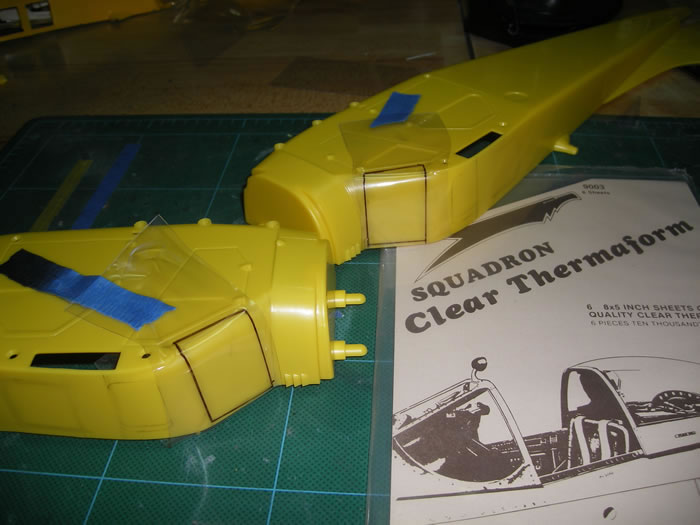
The intention is to portray this splendid aircraft in its own might, therefore, the model shows a bit of tear and wear built into it, and despite the shiny paint job, if you look closer you will see some leading edge dents, scratches, worn paint and oil streaks. The model was placed in its natural environment, a lake. I built a scene portraying the Beaver at a familiar wooden pier, the kind often found on lakes all over, with some interesting supporting elements such as a completely scratch built balsa row boat, wooden pier and accessories, and three supporting figures, a lineman releasing the Beaver moorings, a boatman grabbing the row boat, and a fisherman, accompanied by his dog, a Golden Retriever, behind the Beaver, trying not to get his cap blown off by the prop-wash of the starting engine, while holding his fishing cane tight against the pull of the catch of the moment. The Beaver hosts lights, action and sound, (Audio-animatronics, a term coined by the late Walt Disney). When the start button is momentarily depressed the system starts the plane’s lights and engine. The prop revs up to the sound of the starting Right Cyclone 945 radial. The engine starts to idle, revs up to speed, back to idle, revs up again and then back to idle and shuts down thanks to the excellent motor controller/sound circuit set from http://www.dynamicscalemodeling.com/. The whole action takes place in around 1 minute 40 seconds and then resets until the next time the button is depressed.
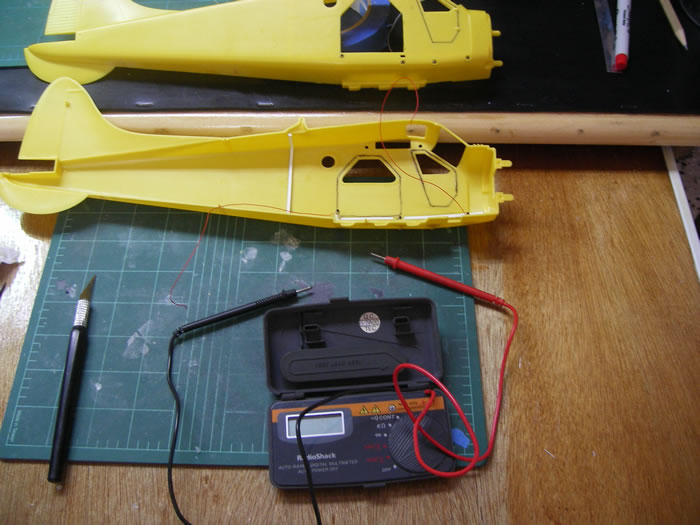
As you will see, there is a lot of work involved in creating this scene with a snap together generic 1/24 scale Beaver and it is my intention to present to you a far better model of this outstanding plane.
The sequence of images shows the process of adding windows, windshield, interior details pilot figure and a completely scratch built instrument panel.

The work involved 110 modifications / scratch built items (email me for a complete list). The model came with raised rivets, typical of the Beaver, but to be able to paint the model and polish that paint I had to get rid of the rivets and sanded them flush and re-scribed each and every one (close to 3000 rivets!). Some flying 1956 Beavers today have been re-paneled and they host flush rivets, so taking that into account I decided to go for the re-paneled version.
I used Squadron’s Clear Thermaform plastic to make the windows, windscreens and even the wing tip nav light covers.
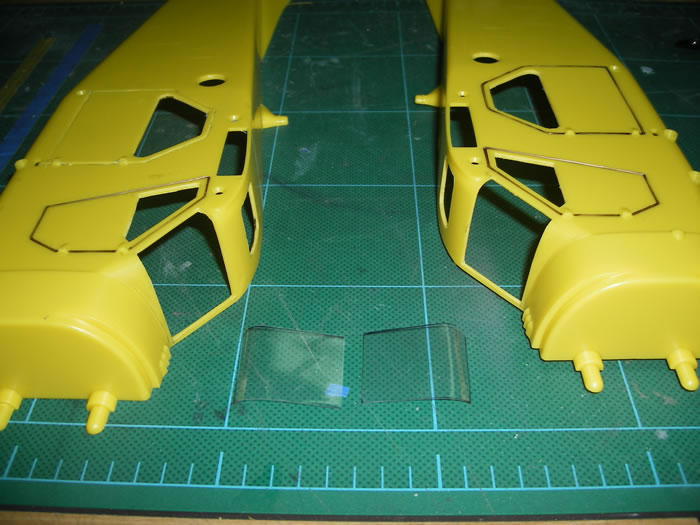
To illuminate the model I used strictly LED’s with a flasher circuit I built using a 555 chip.
Since the model is heavy and I needed to have the ability to separate it from the pontoons that ended up stuck in the simulated water / lake so I can hand carry it to the Nationals, I decided to replace the model plastic legs with ones I made from brass. Incidentally, the brass legs also serve as electrical connection between the incoming wires in the pontoons and the circuits inside the model! Other significant and very visible modifications were the control surfaces. I cut and repositioned all of them for a more realistic look.
The model was painted with Tamiya acrylics and polished to a high shine with micro mesh (3200 to 12000 grit) and a final polish with Novus #2 and #1.
On the other hand, I designed, created and built from scratch the row boat and the pier to include the tool box and water piping. I the added hand tools from different 1/24 kits I had laying around.
The figures are a Fujimi and Preiser. I used one of the Fujimi mechanics cutting him in sections and repositioning as needed using fine wire and then Tamiya epoxy clay to fill gaps and create the turtle neck and jacket. I also created the David Clark headset with Tamiya epoxy clay and wire. Due to the lack of good 1/24 scale model figures, the other figures are Preiser that came pre-painted. I actually re-painted them a bit and added details.
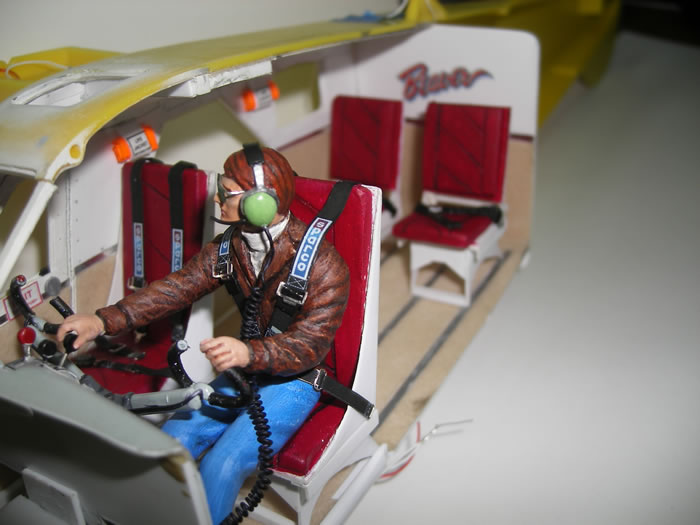
Details include the fishing line, the accessories inside the fisherman’s tool box and the addition of the loyal dog!
For the water I used Realistic Water from Woodland Scenics. This is an air drying polymer, that you pour a thin layer at a time to replicate water. To be honest to you all, it seems like it never completely cure, but created the effect. I poured a thin coat at a time over a base made of painted foam board reinforced with strips of bass wood which houses part of the electronics. (email me for more details).
The electronics are comprised of the excellent system I obtained from my good friend Clyde Sasaki of http://www.dynamicscalemodeling.com/.
Well folks, I could write a term paper about building and detailing the Beaver, but is not the idea here. Suffice is to say that this project involved very long hours of hard work, scratch building, modifications, gallons of coffee and many prayers. The end result is an amazing model that you seldom see around, let alone done this way. I hope you all enjoy my humble work. If anyone needs more info on this project, please email me and I’ll be more than happy to share with you
Mode, Text and Images Copyright © 2009 George R. Mustafa
Page Created 28 September, 2009
Last Updated
28 September, 2009
Back to
HyperScale Main Page

|
Home
| What's New |
Features |
Gallery |
Reviews |
Reference |
Forum |
Search